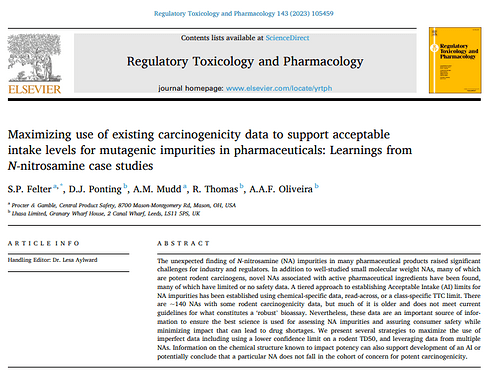A fantastic publication by @SusanFelter et al. “Maximizing use of existing carcinogenicity data to support acceptable intake levels for mutagenic impurities in pharmaceuticals: Learnings from N-nitrosamine case studies”
Abstract
The unexpected finding of N- nitrosamine (NA) impurities in many pharmaceutical products raised significant challenges for industry and regulators. In addition to well-studied small molecular weight NAs, many of which are potent rodent carcinogens, novel NAs associated with active pharmaceutical ingredients have been found, many of which have limited or no safety data. A tiered approach to establishing Acceptable Intake (AI) limits for NA impurities has been established using chemical-specific data, read-across, or a class-specific TTC limit. There are ∼140 NAs with some rodent carcinogenicity data, but much of it is older and does not meet current guidelines for what constitutes a ‘robust’ bioassay. Nevertheless, these data are an important source of information to ensure the best science is used for assessing NA impurities and assuring consumer safety while minimizing impact that can lead to drug shortages. We present several strategies to maximize the use of imperfect data including using a lower confidence limit on a rodent TD50, and leveraging data from multiple NAs. Information on the chemical structure known to impact potency can also support development of an AI or potentially conclude that a particular NA does not fall in the cohort of concern for potent carcinogenicity.
